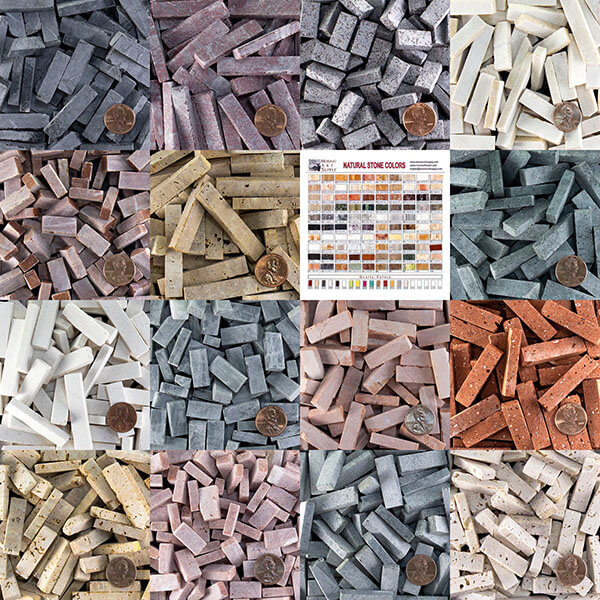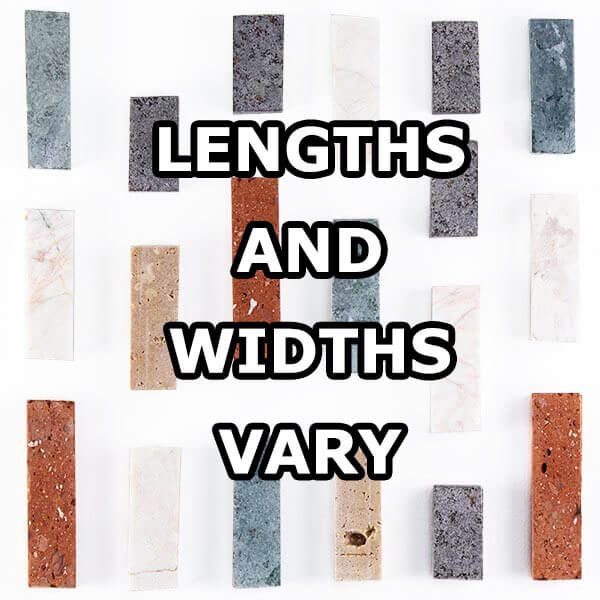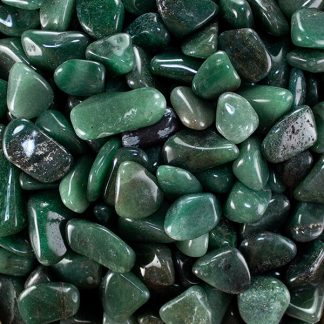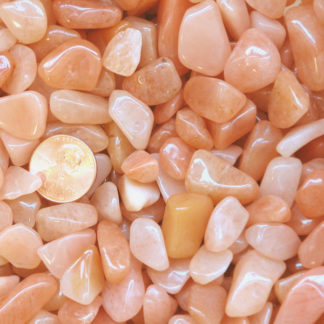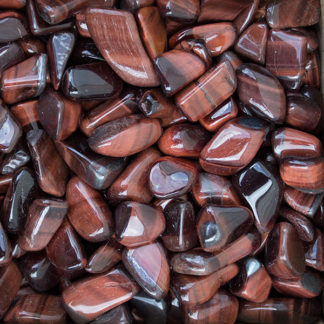Description
Morjo™ Marble Mosaic Cutting Strips are natural marble and stone tiles for making mosaic icons, fine art murals, and architectural coverings. Professional mosaic artists in Europe use this material to make ancient reproductions and original art. They can mount flat, laid on edge, or nipped short and laid on end to expose the natural cleaved surface.
The sides of the strips have a honed and unpolished finish. The sample board and sealed sample product photos show the color intensity when using a stone enhancer sealer, available from most local building material stores. Do NOT order sealers online during winter months where they can freeze during shipment.
WARNING: The widths vary between 8mm and 12mm. The lengths vary as shown in the photos, roughly 3/4 inch to 2 inches. These are professional cutting strips, not finished tiles. Do not order if you need uniform lengths or an unvarying width.
Cutting Marble Mosaic Strips
Marble Mosaic Cutting Strips are the easiest to cut stone we have ever used, and the reason is simple: the 6mm thickness is ideal for cutting yet still thick enough for the stone to have cohesive strength. You can cut these with an ordinary Tile Nipper! Depending on your grip strength, you may want to use a Compound Tile Nipper for even easier cuts.
SCRAP RATE: The amount of cutting waste and unexpected breakage from marble cutting strips varies by the type of stone. Most varieties cut with minimal waste, but some have 5% or even 10% cutting scrap rates depending on how small you are cutting the pieces. Please do not order if your learning curve or budget cannot tolerate some scrap. This professional rendering material represents the best of what is available on the market.
A Marble File is extremely useful for shaping hard materials. It is much easier to file off a tiny amount than it is to try to cut off a tiny amount.
Morjo™ Marble Mosaic Cutting Strips 6mm thick 1 lb
- sales unit: 1 POUND loose marble tile strips.
- piece count and lengths vary.
- honed-finish natural dye-free stone.
- thickness: 6mm (just under 1/4 inch).
- width: varies 8mm-12mm.
- length: varies 12mm-15mm (~3/4 inch to ~2 inches).
- coverage: depends whether mounting flat (6mm thick) or on edge.
- recommended for dry locations where water cannot pool.
- vulnerable to freeze damage like all porous materials.
- should be sealed with a tile and grout sealer to minimize staining and freeze damage.
Marble & Stone Material Clarification
Many varieties of marble mosaic tile are not technically marble. Other varieties of stone provide colors not available in marble, but all our marble is dye-free natural stone with an unsealed honed finish. The bottom of the factory sample board includes a separate section of synthetic stone described as “Quartz Colors” that we do not sell.
Expect Product Variation in Marble
Marble mosaic cutting strips are made of natural stone and as such have natural variation in pattern and coloration between pieces. That being said, this manufacturer produces fairly consistent batches and professional artists select it for that reason.
Avoid Matching with Other Manufacturers
Avoid matching our stone by color name to stone from other brands. Just because two marble varieties have same name does not mean they were sourced at the same quarry. There are many natural varieties of travertines, emperadors, etc. Two different factories or quarries might use the same name for stones that look different from each other.
Always Gather All Project Material Before Installing
Be aware that all forms of mosaic tile can and do vary by manufacturer batch. Given that, you should never order your materials in stages or begin installing tile before you have all that you will need. Even the most expensive brands of Italian glass tile come with warnings to inspect and mix different boxes of their tile before you install it. This caveat certainly applies to natural stone!
Marble Cutting Strips Coverage
Coverage depends on whether you are mounting the pieces flat (6mm thick) or on edge, or nipping short pieces and positioning with the cleaved face up. Laying the pieces flat, a pound covers about 42 square inches or 0.29 square feet. That means you need 3.4 pounds to cover 1 square foot.
Compatibility
Marble strip thickness is just under 1/4″, which is about twice as thick as most molded glass mosaic tile. When people augment stone tile with glass, they usually use the traditional hand-cut mosaic glass known as smalti, which has a similar thickness to stone tiles.
IMPORTANT INSTALLATION TIP
Grout will stain unpolished and unsealed stone tile because it is porous. Stone tile has to be sealed with a tile and grout sealer BEFORE you grout it. However, you shouldn’t seal any surface where grout or glue needs to stick to the stone (the sides). Here is what we recommend for pre-sealing porous materials before grouting:
- Glue or cement your mosaic tiles into place.
- Use a rag dampened with sealer or a small artists paint brush to seal only the top faces of the tiles.
- Take care not to drip sealer down between the tiles or down the sides of the tiles.
We use TileLab brand Grout and Tile Sealer for a normal seal. To slightly enhance/darken the stone colors (recommended), we use TileLab brand Stone Enhancer and Sealer. Both of these products are available at Home Depot. More expensive premium products are available. Scroll through product photos to see the difference in each variation with enhancer.
Using Marble Strips in Outdoor Mosaic Art
Most people think that stone is more durable than glass for outdoor mosaic art, but actually the reverse is true for several reasons:
Marble & Stone Hardness Varies
Not all stone is hard, and natural stone only comes in so many colors. To get the range of colors needed to make a mosaic, softer varieties of stone are sometimes all that is available for a particular color. One example is honey onyx (actually a calcite). This is especially true when you are discussing affordable types of stone. Sure, emeralds are a rich green, but they are also relatively rare, small and expensive.
Stone Tile Porosity and Freeze Damage
Glass is non-porous, and thus water cannot penetrate into it and then freeze and expand. But it can cause porous stone to crack and flack away. Keep in mind that the reason we have so many ancient Greek and Roman mosaics after millennia is that the Mediterranean climate is relatively warm and dry. It also helped that many of the ones we now have were buried for centuries.
Marble Tile is Chemically Vulnerable
Remember that not all marble mosaic tile is technically marble, and even if it were, marble isn’t that hard. It is also susceptible to chemical damage by naturally occurring substances. For example, decaying organic matter such as rotting leaves produces acid. Marble dissolves in acid. (You can actually listen to marble fizz when you pour vinegar on it). This is how the acid rain from automobile exhaust in European cities has melted ancient statues. Other varieties of stone are also vulnerable to organic acids and other natural substances.
How To Make Marble Mosaics Last
Marble mosaic cutting strips (and the other stone types described as marble) work best for indoor mosaics where water cannot pool on the surface. However, marble can hold up outdoors provided you seal it very well with a tile and grout sealer and check the seal every few years. (Make sure that water is still beading on the surface instead of soaking in). Sealing and periodic checking are advised with all outdoor mosaics because grout is porous and vulnerable to freeze damage.
Outdoor marble mosaics should be on vertical surfaces such as walls instead of horizontal surfaces such as bench seats or paths.
How To Make Mosaic Art
For more advice on making mosaic art, please see our page of Mosaic FAQ or our Mosaic Information Guide, which lists instructional pages described by topic. We also post new articles about making mosaics at our How to Mosaic Blog.
[product_table category=”marble-cutting-strips-6mm” widths=”auto,auto,12,12,20″]